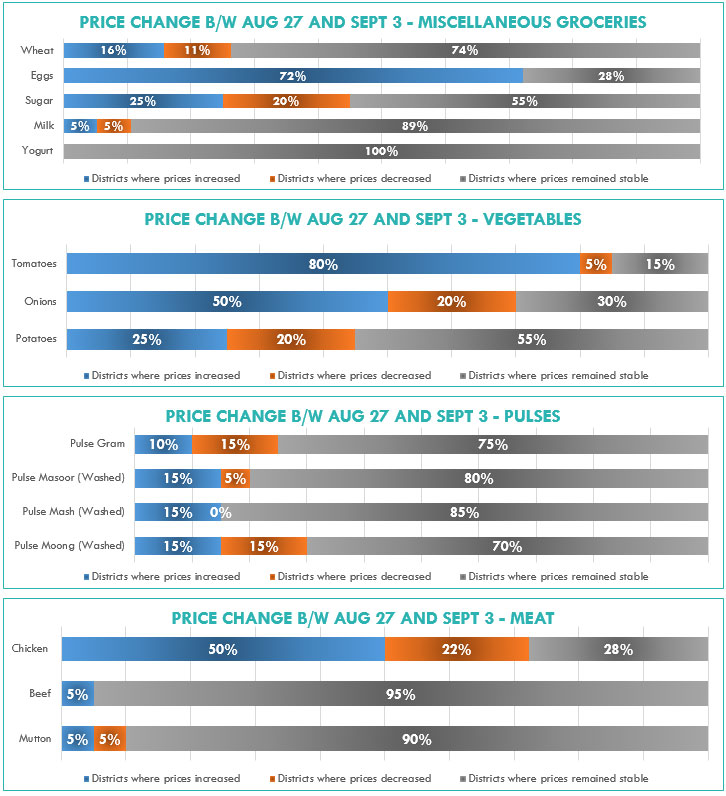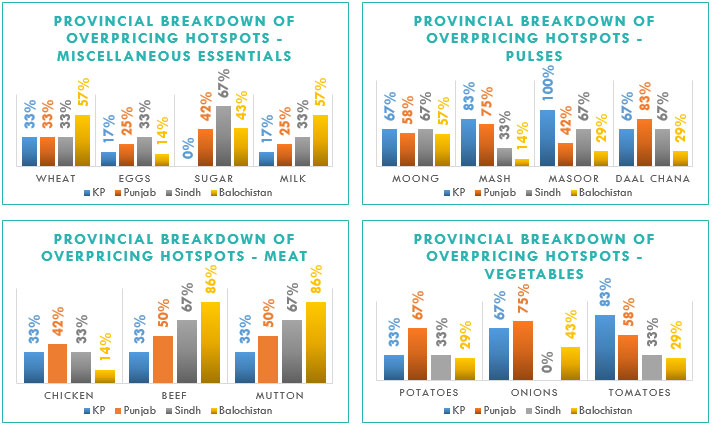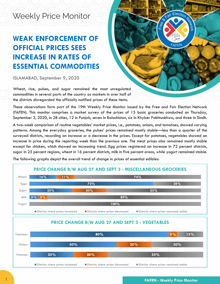ISLAMABAD, September 9, 2020: Wheat, rice, pulses, and sugar remained the most unregulated commodities in several parts of the country as markets in over half of the districts disregarded the officially notified prices of these items.
These observations form part of the 19th Weekly Price Monitor issued by the Free and Fair Election Network (FAFEN). This monitor comprises a market survey of the prices of 15 basic groceries conducted on Thursday, September 3, 2020, in 28 cities, 12 in Punjab, seven in Balochistan, six in Khyber Pakhtunkhwa, and three in Sindh.
A two-week comparison of routine vegetables’ market prices, i.e., potatoes, onions, and tomatoes, showed varying patterns. Among the everyday groceries, the pulses’ prices remained mostly stable—less than a quarter of the surveyed districts, recording an increase or a decrease in the prices. Except for potatoes, vegetables showed an increase in price during the reporting week than the previous one. The meat prices also remained mostly stable except for chicken, which showed an increasing trend. Egg prices registered an increase in 72 percent districts, sugar in 25 percent regions, wheat in 16 percent districts, milk in five percent areas, while yogurt remained stable.
The following graphs depict the overall trend of change in prices of essential edibles:

The officially notified price lists of essential commodities were unavailable in various parts of the country during the reporting week. The official rates of cooking oil, tea, and toilet soap were not available in all the surveyed cities. The price of vegetable ghee was missing in 96 percent of the regions. Khyber Pakhtunkhwa, Punjab, and Sindh accounted for 100 percent unavailability, while 86 percent of Balochistan’s surveyed districts lacked the official prices.
The official sugar prices were missing in more than half (64 percent) of the districts—100 percent in KP, 58 percent in Punjab, 57 percent in Balochistan, and 33 percent in Sindh. Similarly, the Basmati rice prices were not obtainable in 92 percent of Punjab districts, 50 percent in Khyber Pakhtunkhwa, and 43 percent in Balochistan. In contrast, the official rates were available at all the surveyed markets in Sindh.
The official rates of four pulses—moong, masoor, mash, and chana—were generally available in KP, Punjab, and Sindh. However, they were missing at several markets in Balochistan. Daal mash prices were unavailable in 71 percent of the markets. Fifty-seven percent lacked daal masoor rates, 43 percent daal chana prices, and another 14 percent did not have daal moong rates. At the same time, milk and yogurt prices were not publicly obtainable in 29 percent areas.
Moreover, mutton and beef prices were missing in 14 percent and 11 percent of the districts. Provincially, the beef and mutton prices were missing in 33 percent regions of Sindh. In Khyber Pakhtunkhwa, the mutton and beef prices were unavailable in 33 percent and 17 percent of the areas. The meat prices used to be publicly accessible in all Balochistan markets during the previous weeks. The official price lists of regular vegetables—potatoes, onions, and tomatoes—were inaccessible in around 14 percent of Balochistan markets. At the same time, elsewhere, they were publicly available.
The interactive graph below shows the percentage of areas where official prices of essential commodities were missing:
Besides the unavailability of officially notified prices of essential groceries, the official prices’ enforcement remained weak.
Daal chana price remained the most unregulated, with 64 percent of the markets selling it at a higher rate than its official price. Similarly, daal moong was overpriced in 61 percent markets and daal mash and daal masoor in 57 percent and 54 percent. Unlike the previous weeks, the pulses’ overpricing was most prominent in Khyber Pakhtunkhwa, no market selling any of the four pulses at official prices.
Nearly 57 percent of markets sold onions at higher than official prices, while 54 percent and 46 percent markets overpriced tomatoes and onions. In the meat category, beef and mutton (average quality with bone) were overpriced in 57 percent of the surveyed districts each, and chicken in 32 percent.
The market rates of eggs per dozen were above the officially notified prices in 21 percent districts. Simultaneously, the yogurt and milk rates were higher than the official ones in 43 percent and 32 percent of the surveyed areas.

TDEA-FAFEN generates the Weekly Price Monitor covering 15 essential kitchen items, including wheat, pulses, oil, sugar, and perishable commodities like meat and vegetables. It does this considering the need for an independent and regular assessment of the availability of such items. The observers obtain the official prices from the officials of district administrations or market committees, and collect the wholesale prices through market surveys. In Punjab’s case, the government price app Qeemat Punjab is also used to get the official rates.
To download the report, click here


